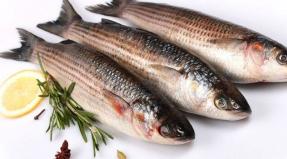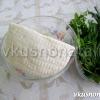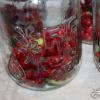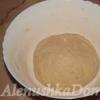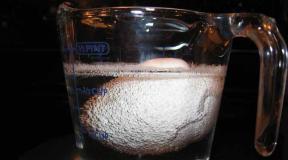How to color eggs with curry. How to dye eggs golden yellow
Of course, onion coloring of eggs is traditional, bright carmine or brick red color is always present among painted eggs, but I also want to get other colors to make the Easter table even more elegant.
We dye the eggs yellow with turmeric.
To get a beautiful yellow color, reminiscent of the shade of the sun from children's gouache drawings, use the spice turmeric. Dilute 2-3 tablespoons of turmeric into one and a half liters of water to obtain an orange-yellow infusion, into which eggs are placed for coloring. If you boil the eggs, the color will be more intense than when soaked.
Turmeric is a rather strong dye, so if you roll a hot egg just taken out of the pan over turmeric powder evenly scattered on a cotton napkin and leave to cool, then after washing it off you will get an egg with freckles.

Instead of turmeric, you can use curry powder or saffron, which also produce intense shades of yellow when dyed.
We paint eggs brown and burgundy using beets.
If you want to get a bright burgundy or delicate pink color, beets will come to the rescue, which is also an excellent dye and is often used in this capacity for cooking.

If you don’t mind the beets, then squeeze the juice out of it and put previously boiled eggs with white shells in it to soak for 5-6 hours. The result is a bright pink-burgundy color. With shorter soaking, we get more delicate shades. If you cook it in beet juice, you get a deep, rich burgundy color.
You can use beet peels when the root vegetable itself is used for cooking. I thoroughly wash the raw beets under water with a brush, clean them and send them to cook, and cut the remaining skins into strips and add them to hot water. We cook eggs together with them. The more beets, the more intense burgundy color we get. With prolonged cooking, the protein inside takes on a burgundy hue.

You can also color the shell of a white egg with “straws”. To do this, raw beets are grated on a fine grater, laid out on a piece of cloth and a boiled egg is wrapped inside this pillow.
We dye eggs blue using red cabbage.
An infusion of red cabbage will give Easter eggs an unexpected blue color. Cut half of a large red-leaved cabbage into smaller pieces and brew with a liter of hot water, leave to steep overnight. Then add a tablespoon of vinegar and soak the boiled eggs for several hours. We get a color from blue to true blue.

If you put a thin strip of tape on each egg, you will get a striped pattern on the shell.
We paint the eggs blue-purple using berries.
To color eggs in purple and bluish shades, you can use berry infusions. Blueberries, currants, and chokeberries are suitable. Everyone remembers how difficult it is to remove stains from these berries from white T-shirts.


Intense color can be obtained with a significant concentration of berry syrup, in which pre-boiled eggs with white shells are soaked. The eggs are soaked while still hot, and they need to infuse for good color for 6 - 7 hours.
What is better to paint them with: natural or chemical dyes? I think that these questions concern any young housewife. Experienced housewives will grin at how difficult it is! But, as you know, every business has its own nuances and everything comes with experience. I’m also a young housewife, but I really want to prepare for Easter properly: bake Easter cake, make Easter delicious and, of course, paint the eggs so that they turn out bright and beautiful. Therefore, I took the issue of egg coloring seriously. I looked all over the Internet and various magazines and this is what I found out.
The first step is to prepare the eggs that you intend to paint. Eggs need to be removed from the refrigerator an hour before coloring and let them lie on the table. They need to be washed, preferably with a sponge and soap, to remove all the fat from the surface of the egg. Then place the eggs on a plate covered with a napkin and let them air dry. It is recommended to put eggs into the paint using a cloth or gloves. I tried to do this: I placed a clean spoon near the egg and rolled it onto the spoon with a cloth, and then lowered it into the saucepan. And let me remind everyone of the well-known trick, so that the eggs do not burst, add a tablespoon of salt to the pan. So, the eggs are ready. What are we going to paint with?
I found out that eggs can be colored with two types of dyes: natural and chemical.
Chemical dyes are sold in stores. With their help, eggs of different colors are obtained: red, yellow, green, blue. Dilute paints in hot boiled water. Strain. Add 2 tbsp. l. vinegar per 0.5 liters of water. Instead of vinegar, add 1 tsp to yellow and orange paint. salt. Place the egg on a spoon without touching it with your hands and dip it into the paint. That's all the wisdom. One note: when purchasing paint, be sure to check the expiration date. If the paint is expired, then nothing may work.
Looking at my little son, I realized that the chemical method of coloring eggs is not suitable for us.
Now about natural dyes. It turns out that there are simply an infinite number of ways to color eggs this way, ranging from traditional onion skins to violet flowers and turmeric.
I will give a description of the most interesting, in my opinion.
Turmeric - to get yellow eggs. You can color them in 2 tablespoons of turmeric. Boil the eggs for up to half an hour to intensify the color.
Spinach is used to produce green eggs. It is necessary to boil the eggs from the spinach for 20-30 minutes.
Cranberries and beets will give the eggs a soft pink and red color. You can achieve these colors in the following ways: soak eggs in beet or cranberry juice, which will give you a pink color. Boil eggs with chopped beets to get red eggs. You can rub an egg with a handful of cranberries to get a soft pink color.
Violet flowers will give Easter eggs a purple color. To do this, you need to put flowers and eggs in hot water and soak overnight. Adding a little lemon juice to water will give you a lavender color.
Coffee is used to produce a dark brown color. To do this, boil the eggs in 250 ml of coffee.
Red onion peel. You need to take 4 cups of red onion skins. Boil eggs for 30 minutes to 1 hour. Depending on the time of soaking, the eggs will turn from bright scarlet to dark red.
The peel of an ordinary onion. The most famous and time-tested dye. The eggs range from light red to dark brown. This depends on the amount of husk used and the time of painting.
To know exactly which methods are effective, I conducted a small experiment and painted several eggs in advance.
There were cranberries in the refrigerator. I rubbed an egg on her. I’ll say right away that the result was not impressive. It was not possible to obtain an even color. The egg became spots of pinkish-lilac color. In order to get a really beautiful color you need to soak the eggs in juice.
I didn’t have pure turmeric powder, but I did have curry seasoning. I put 2 tablespoons of curry into 0.5 liters of water and boiled the solution for 15 minutes. Then she put an egg in a saucepan with seasoning, boiled it and left it in the solution for another day. The egg became a soft yellow color. I liked it (the photo below is the egg in the center). One note: if you paint eggs with curry seasoning, it is better to wrap the powder in a cloth so that there are no lumps left on the egg later.
An egg boiled in spinach turned out to be light green in color.
The eggs painted in onion skins turned out best. If you want a light brown color, use white eggs; for a dark brown color, brown eggs are suitable.
So, let's prepare a decoction. Take a lot of onion skins, wash them, put them in a saucepan, add water and cook for about half an hour from the moment of boiling to get a strong infusion. Place the eggs in the pan. The longer you cook, the darker the color will turn out.
You can make eggs with ornaments, eggs with speckles, eggs with streaks, or eggs with stripes.
Take a beautiful leaf of parsley or cilantro, or maybe you have a suitable flower on your windowsill. Wet the leaf with water, attach it to the egg, and spread it out. Then place the egg on a piece of nylon tights, carefully collect the nylon, thereby pressing the leaf to the surface of the egg, and tie it with a thread on the back side of the leaf.
You can cut out some kind of flower or ornament from the paper. I cut out the letters XB. I wet the paper and applied it to the egg. She wrapped it in nylon and tied it tightly.
Speckled eggs.
To get motley eggs, you need to roll wet eggs in
dry rice, wrap it in nylon (tie the ends of the nylon tightly with thread so that the rice sticks to the egg) and cook in onion skins as usual.
Marbled eggs.
Wrap the egg in onion peel, tie it in nylon, and cook in a mild decoction of the peel.
Striped eggs.
Tie the eggs with rubber bands from money and boil them in the husks, the eggs will be striped.
Once the eggs have colored, remove them from the pan and let dry. Then rub with a cloth soaked in sunflower oil. The eggs will shine.
Time flies quickly. It seems like just yesterday that Lent began, and Easter is already right around the corner. A joyful time of anticipation for the holiday! Have you already thought about it, made a to-do list and planned your time? I suggest you think about natural dyes for eggs this year. A classic of the genre - of course, however, this is far from the only possible option. Last year I showed it to you - in my opinion, it turned out very, very tender, airy, touching. This time I decided to try dye eggs with turmeric. What to say? I am pleased. The color came out very warm! Rich, juicy and even somewhat hot! The children actively helped me - and therefore the Easter eggs this time are not perfectly evenly colored, but I like it even better, it turned out cozy and homely, without glamorous soulless glossiness. Well, the children are happy - they proudly show everyone the results of their work and turn up their noses in every possible way, saying that this is their contribution to the preparation for Easter.
Turmeric is ginger's closest relative. Outwardly, it is very similar to the same knotty roots as ginger. It is collected, cleaned, boiled, dried, and then turned into powder, which is used in cooking for a variety of purposes.
In general, there is nothing complicated in the question. Nothing at all. But I still want to talk about the process - maybe you will be inspired by its simplicity and also color Easter eggs with natural dyes this year. Regardless of whether you like the finished result, you are guaranteed to get a lot of positive emotions from the process of dyeing eggs with turmeric.
Initially, it is worth mentioning that dyeing with turmeric costs white eggs. Brown eggs will only acquire a faint warm tint, but will not produce a pronounced yellow color.
First of all, we take the eggs out of the refrigerator, wash them and leave them on the table so that they warm up a little. The main reason for eggs cracking during cooking is precisely the temperature difference, so it is important to place the eggs in a warm place in advance.
Well, then carefully put it in the pan.

We dilute turmeric separately - we took about 50 g of dry powder for 1 glass of water. This was quite enough. Initially it was enough. But the children decided that they needed to recycle another packet of turmeric - and additionally poured a little more spice into the ladle (because of this, it turned out that our Easter eggs were unevenly colored). You are not children, so turn off impulsiveness and turn on common sense - and you will have an even color.
Pour water with turmeric into the pan, add tap water so that the liquid covers the eggs completely. And let it cook - bring to a boil, reduce the heat and simmer for 10 minutes.
After this, we leave the eggs in the turmeric broth overnight, take them out in the morning, wash them and wipe them with a napkin.
If you are accustomed to pouring cold water into your eggs after boiling them to make the cleaning process easier, do just that, just don’t throw out the broth. Strain, pour into a bowl, wait for it to cool, add a couple of tablespoons of table vinegar, lay out the eggs and leave at least overnight. There are, of course, more games, but the color will be more even, and the eggs will probably be easier to peel.

Well, that's all. You can celebrate the bright holiday of the Resurrection of Christ!
How to dye eggs for Easter without dyes The yellow color comes from a decoction of chamomile with the addition of turmeric and carrots. Preparation of dye: take 1 liter of water, 3 tablespoons of turmeric/curry powder and grated red carrots, cook for 30 minutes. take 1 liter of water, 4 or 5 sachets of chamomile, cook for 20-30 minutes. Orange color comes from orange zest juice, tangerine zest juice, paprika, and red carrot juice. Preparation of dye: 4 tbsp. spoons of paprika need to be boiled for 30 minutes in a saucepan with a glass of water, then place the eggs in the broth. Soak boiled hot eggs in carrot juice with the addition of turmeric (the proportions are arbitrary and depend on which shade you like best). The brick-red color comes from an infusion of strong black tea and onion peels (you can get a color up to dark brown-burgundy). You can also use pomegranate peel to get a brown color. Preparation of dye: Collect onion peels or pomegranate peels in a wide saucepan. Fill with water until the pan is not full. Let the husk/peel simmer over low heat. Cook for 45-50 minutes to achieve a dark, rich color. The pink color comes from twigs or cherry bark and beet juice. Preparation of the dye: pour 4 cups of chopped beets with 4 cups of water, cook for 35 minutes, drain the colored water and soak the eggs in it. A bluish-gray, purple color can be obtained using blueberries, lingonberries or blueberries (the berries must be frozen from last year), red cabbage leaves - the broth will be red, but the eggs will turn blue. Preparation of the dye: Boil the blueberries briefly and strain. Cool. Place eggs washed in warm water and cook. The color intensity depends on the concentration - the number of berries per volume of water. To make the color purple, you need to take a little more blueberries than for a blue color and let it brew for several hours before boiling the eggs in this broth. Green color is given by carrot tops, dried spinach, parsley, nettle, blueberry decoction + turmeric. Preparation of dye: For 2-3 eggs and 0.5 liters of water, take about a handful of carrot tops. Cook for 30 minutes. Drop the eggs. Boil eggs with dried nettle infusion (3 tablespoons of crushed nettle per liter of water). For 1 liter of blueberry decoction - 2-3 full teaspoons of turmeric powder. To avoid the appearance of lumps, first grind the turmeric with water in a small bowl and only then place it in the blueberry decoction. Note: To prevent eggs from cracking during coloring, they should not be cold (from the refrigerator), they should be kept at room temperature for several hours and washed in warm water before coloring. If, after coloring, you put the eggs in the same broth in the refrigerator overnight, the color of the shell will be brighter. After coloring, you can wipe the eggs with sunflower oil, then they will acquire a stunning shine.
A basket of colorful painted eggs on the Easter table is a tradition that invariably brings a smile to adults and excitement among children. Everyone wants to try an Easter egg as soon as possible - after all, since it looks so bright, it probably tastes something special. Needless to say, today you won’t surprise anyone with the bright colors of Easter eggs - the Chinese chemical industry works without interruption, supplying our market with dyes of very dubious composition and quality. And if you want your guests to treat themselves to Easter eggs without fear, then you will probably try to use natural paints for them, without chemicals that can easily penetrate the porous shell. And it’s not a fact that after this the eggs will remain edible. Fortunately, it is possible to completely eliminate chemicals when coloring eggs. And it is not at all necessary to use the number one natural dye, which was and remains onion skins, which can give an intense brick-red color. An equally pleasant yellow color can be produced by the well-known Indian seasoning turmeric. And now I’ll tell you in detail and clearly show you how to color eggs with turmeric. Turmeric is a plant that can safely be called unique. The homeland of turmeric is India, where it is widely used not only as a seasoning, but also added to cosmetics and even fabrics are dyed with turmeric. The big “plus” of turmeric is that the seasoning is relatively inexpensive, is widely available on sale, and is packaged in decent-sized bags. In cooking, it is used to color boiled rice and to give an intense yellow color to Korean cabbage. I hope your first experience using turmeric to color eggs will inspire you to use the spice in other ways. For example, adding literally a pinch to the Easter cake dough, you will get a delicious sunny shade of rich crumb.
Ingredients for coloring eggs with turmeric:
- Chicken eggs – 1 dozen
- Turmeric – 1 sachet (20 g)

How to color eggs with turmeric (step by step instructions)
A 20g sachet of turmeric seasoning is usually enough for 1.5-2 liters of water. So, add turmeric to a saucepan with water. We put the dishes on the fire. We wait until the water boils. Reduce the heat to moderate, cook the turmeric for about 15 minutes. By the way, take a pan that you don’t mind, because its walls will turn yellow. Also, if you want to end up with a more saturated color of the eggs, then double the amount of turmeric.

While you are preparing the solution to color the eggs yellow, work on the eggs. They must be washed under warm water. It is recommended to use a soft sponge during the process.
The yellow turmeric solution is ready. Cool it a little, and then transfer chicken eggs into it. Tip: to prevent eggs from bursting during cooking, as sometimes happens, they should be removed from the refrigerator in advance so that they warm up. If you don’t have time, you can keep the eggs in warm water for a while and then place them in a saucepan. Cook the eggs for about 8-10 minutes. The solution should completely cover the eggs. Make sure that the boil is not too intense.

We take out the eggs, which have acquired a pleasant yellow color after cooking.

Let cool and decorate with stickers (optional).

So, using a spice like turmeric, we were able to color chicken eggs a beautiful yellow color for Easter. This method is not only economical and simple, but also absolutely harmless.


